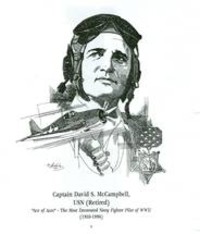Hall of Fame
McCampbell, Captain David S.

Born in Bessemer, Alabama, David McCampbell attended Georgia Tech before being appointed to the United States Naval Academy, where he graduated in 1933. His commission was delayed a year because of manpower cutbacks during the Depression. McCampbell completed flight training in 1938 and served two years with Fighter Squadron 4 before being transferred to the USS Wasp as Landing Signal Officer. In June of 1942, the Wasp was sent to support landings on Guadalcanal where the ship was subsequently sunk.
McCampbell was returned to the States where he became Landing Signal Officer Instructor at NAS, Melbourne, Florida. In August 1943, McCampbell took command of Fighter Squadron 15 which, following a brief shakedown became Air Group 15. It included fighter, bomber and torpedo planes and, based aboard the USS Hornet, sailed to Hawaii. Air Group IS, embarked on the USS Essex April 10, 1944. For the next seven months the Essex and its air group were to see almost continuous combat including two major air-sea battles. On June 19, 1944, McCampbell let his fighter planes against a force of 80 Japanese carrier-based aircraft bearing down on the U. S. Fleet (Battle of the Philippine Sea). He destroyed seven of the hostile planes. The enemy, which outnumbered US forces, was routed. A few days later, during the battles of Leyte Gulf, Commander McCampbell, assisted by one other pilot, intercepted a formation of 60 land-based enemy planes. McCampbell shot down nine Japanese planes, and his fellow-pilot downed five. The remaining enemy forces abandoned the attack. The feat of the nine plane "shoot down" on a single mission is unequaled in the annals of aerial combat. The following day, Commander McCampbell was assigned as Target coordinator for a strike force composed of planes from three task groups of the Third fleet. Under his command this strike force attached the Northern Japanese Force, sinking four aircraft carriers, one heavy cruiser and one destroyer. Numerous other Japanese ships were damaged.
The only plane flown by McCampbell in combat was the renowned Grumman F-6F Hellcat. A like model is on display at the Naval Aviation Museum, Pensacola, Florida. It was in the Hellcat that he shot down 34 enemy aircraft and destroyed an additional 24 on the ground, earning his title Navy's "Ace of Aces." President Franklin Roosevelt awarded the Congressional Medal of Honor to David McCampbell at the White House on January 10, 1945. When Air Group 15 left the combat theater, McCampbell was the most decorated Navy fighter pilot in World War II. He later became the only U.S. Congressional Medal of Honor recipient to command an aircraft carrier. Captain McCampbell retired from the Navy in 1964, after thirty-one years of service. He lived in Florida until his death at the age of 86.
Captain David S. McCampbell, USN (Retired), the Navy's "Ace of Aces" was enshrined in the Georgia Aviation Hall of Fame May I, 1999.
